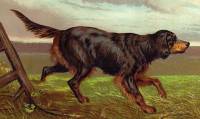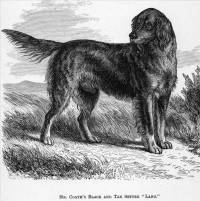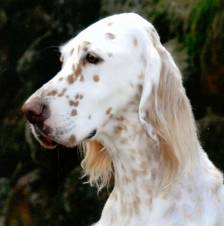Gordon Setters
 Gordon Setter
Gordon Setter
The History of Setters relates how Setters originated. But the Gordon or Black and Tan Setter was originally bred to find game birds that lived in the steep, rugged heather-covered slopes of Scotland. Although this extremely robust dog never enjoyed the same popularity as a field or show dog as his English or Irish Setter cousins, his substantial build and shiny black and tan coat makes him immediately distinctive.
History of the Gordon Setter
 Gordon Setter c 1872
Gordon Setter c 1872
In England the first mention of the Gordon Setter goes back to 'the Whole Art of Fowling by Land or Water' by Gervaise Markham in 1655 AD where he described the black and fallow (tan) hunting dogs. To this end, it is likely that Bloodhound was introduced to improve his scenting abilities. This could account for the more substantial build of the black and tan or Gordon Setter compared to other Setters.
 Gordon Setter 1855
Gordon Setter 1855
The Gordon Setter becomes a Pure Breed
In the early 1800's numbers of Setters were kept in Gordon Castle, Scotland by the Duke of Gordon. By around 1872, the Rev.T.Pearce was considered to be an authority on the breed. Writing under the name 'Idstone', he believed the Colley dog (now either the the Border or Collie Rough) was responsible for the predominately black and tan colour of the Gordon Setter which, before then also had a considerable amount of white. He wrote:
 Gordon Setter 1872
Gordon Setter 1872
The story goes that the Duke (of Gordon) heard of a shepherd's bitch which was a wonderful finder of grouse, pointing them stiffly, finding them when the Setters were at fault, so that the shepherd and his bitch were frequently in request when the castle party was unable to find game. Having ascertained these facts, the Duke bred from her, and so originated the black and tan breed'[1].
Gordon Setter (Aust) 1889
History of Gordon Setters in Australia
One Gordon Setter named Don owned by Mr J DeLittle of Clarendon Street Melbourne was listed in the catalogue of Victoria's first dog show held in 1864[2]. This was the same year that Mr Lachlan MacKinnon imported from Britain a dog and bitch named 'Ponto' and 'Dido' respectively.
 Gordon Setter (Aust) 1892
Gordon Setter (Aust) 1892
Ten years later another pair was imported followed by another six. These included the dog Heather Bounce and a bitch Heather Bloom in 1889, followed by another dog Heather Spark in 1892. These three imports went to Mr Haddon who was considered to be the founder of the modern Gordon Setter in Australasia[4]. By 1910 a total of 31 Gordons had been registered[3].
Mr A.E. Prentice and a small but dedicated band of enthusiasts supported the Gordon Setter through the depression years, believing that he was the best worker of all the Setters for Australian conditions[5].
 Gordon Setter (Aust) 1974
Gordon Setter (Aust) 1974
Then after World World War Two of particular influence on the Gordon Setter in Australia was the show and field titled American Champion Sutherland Hallmark QC (pictured) who arrived here from USA in 1974. He quickly gained his Australian and New Zealand show titles and was a particularly prepotent sire with 67 Champions to his credit. Today he still appears somewhere in the pedigree of many of today's Australian Gordon Setters.
The Gordon Setter Today
Always stylish with a shining deep coal black coat and lustrous brown markings, the Gordon Setter is built like a weight carrying hunter horse. He can weigh almost 30 kilos (65 pounds) be up to 66 cms (26 inches) tall.
Head
 Gordon Setter
Gordon Setter
The head is deep rather than broad. The skull is slightly rounded and broader than the muzzle with a clearly defined stop in between. In profile the length of a line drawn on the skull from the occiput to where the stop commences is slightly longer than the length a line drawn on the muzzle from the bottom of the stop to the end of the nose. These two lines representing the head planes drawn on the skull and the muzzle are almost parallel.
The top and bottom of the muzzle are also parallel but not quite as deep as it is wide. This makes the flews neither pendulous nor snipey and causes the mouth to house a normal scissors bite. The nose is large, broad and black. The eyes are set under the brows and the thin ears are of medium size and set low, lying close to the head.
 Gordon Setter
Gordon Setter
Body
The neck is long and lean, without dewlap. Looking from the front, the chest is not too broad and forelegs have flat bone with straight, strong, upright pasterns. The oval feet with their deeply cushioned pads and well arched toes with plenty of hair between them act as protection for the dog when he is working.
 Gordon Setter
Gordon Setter
In profile the body is not too long. But the shoulder blades are long and close at the withers but never loaded or bulging with muscle. The brisket is deep with the elbows working close to the ribs which are also deep, right through to the back ribs. The slightly arched loin is wide and almost horizontal with the tail set completing the picture. This is despite the tail itself being thick at the root and tapering, being either straight or scimitar in shape, and being allowed to be set either level with or slightly below the level of the back. The hindquarters are broad, strong and muscular with a good turn of stifle and short hock.
Movement
 Gordon Setter
Gordon Setter
At a trot, the Gordon Setter has a steady, free-moving balanced gait with plenty of drive from behind. The coat on the head, front of legs and tips of ears should be short and fine but the body coat is of moderate length. The feather on upper portion of the ears is long and silky, but on the backs of legs it is long and fine. The fringes on the belly may extend to the chest and throat. But despite its varying lengths, the coat should always be as free from curl or wave as possible.
Colour
As with all black and tan breeds the colour is very precisely described. The Gordon Setter's coat is shining coal black with lustrous chestnut red markings. Although a little black penciling on the toes in allowable, the chestnut red is placed as follows:
- A clear spot over each eye not more than ¾ inch (almost 2 cm) in diameter
- On the sides of the muzzle not reaching above the base of the nose
- On the throat
- A large clear spot on each side of the chest
- On the forelegs up to the elbows
- On the inside of the hind legs and inside the thighs
- On the front of the stifle broadening to the outside of the hind legs
- Around the vent
Comparison between the English, Gordon and Irish Setters
| English Setter | Gordon Setter | Irish Setter | |
|---|---|---|---|
| General Appearance | Dog of medium build | Dog of more substantial build than the English Setter | Racy and refined with |
| Colour | A white coat flecked with individual coloured hairs | A black and tan coat | A rich chestnut coat with no trace of black |
 English Setter English Setter |
 Gordon Setter Gordon Setter |
 Irish Setter Irish Setter |
|
| Head | Skull and muzzle of equal length with moderate stop | Head deeper throughout and a little shorter in the muzzle than the English and with a deeper stop | Long and lean oval shaped skull with a moderate sloping stop set between raised eyebrows and well defined occiput and parallel head planes. |
| Eyes | Oval in shape and colour may be hazel or lighter in liver beltons | Always dark in colour and set under the brows | Almond shaped set under the brows |
| Ears | Moderate length set low with velvety tips | Medium size, thin and set low | Set low and well back |
| Mouth | Normal scissors bite | Normal scissors bite | Normal scissors bite |
| Neck | Rather long and elegant without dewlap | Long and lean without dewlap | Moderately long flowing into well laid shoulders |
 English Setter English Setter |
 Gordon Setter Gordon Setter |
 Irish Setter Irish Setter |
|
| Forequarters | Chest deep and forelegs with round bone | Chest deep but close at the withers and forelegs with flat bone | Chest rather narrow and deep Forelegs straight and well boned, |
| Feet | No shape specified but close with well arched toes | Oval with well arched toes and deep cushioning | Small and firm with well arched toes |
| Body | Moderate length with deep brisket | Moderate length with deep brisket and chest not too wide | The high withers give the impression of a slightly sloping topline that slopes gently downwards the moderately arched loin |
| Hindquarters | Loin wide and slightly arched. Hindquarters strong with good turn of stifle | Loin strong and slightly arched but pelvis tending towards the horizontal. Hindquarters strong with good turn of stifle | Powerful with stifle well bent |
| Tail | Medium length set on and carried almost in line with the back, slightly curved or scimitar shaped | Not reaching below the hocks, thick at root and tapering, either straight or scimitar, set in line with or slightly below the level of the back | Strong at root and tapering. Because of the moderately arched loin, it is set on and carried below the level of the back |
| Coat | Long and silky, slightly wavy but never curly | As flat and free of curl as possible | Moderate length and as flat as possible and free from curl |
| Size | Height: Dogs 65-69 cms (25.5-27 ins) Bitches 61-65 cms (24-25.5 ins) | He can weigh almost 30 kilos (65 pounds) be up to 66 cms (26 inches) tall | Not specified |
References and Further Reading
Hot off the Press! Jane has just published a book 'Gundogs Unveiled'. Information on our sister website: www.Rangeairevision.com
[1] 'Idstone' 'The Dog' Published by Cassell, Petter and Galpin London 1872 Chapter XI The Black-tan or Gordon Setter Page 96
[2] Catalogue of the First Exhibition of Sporting & Other Dogs, Thursday & Friday April 7 & 8, 1864 promoted by the Council of the Acclimatisation Society, printed in Melbourne by Mason & Firth, Printers, Flinders Lane West
[3] 'Tyzack's Annual' Compiled by T. W.Tyzack and C.S.Turner Published by the Victorian Poultry and Kennel Club 1912 by Bellamine Bros. Printers, 66-70 Flinders Lane Melbourne Page 90 (Importations) and 37-39 (Stud Book).
[4] W. Beilby 'The Dog in Australasia' published George Robertson & Company in 1897 'The Gordon or Black and Tan Setter' Page 242 - 244
[5] Dr A.B.Maynard 'KCC of Victoria Annual 'On the Bench and in the Field 1933' published by F C Morant 7 Crimea St St Kilda printed by the Horticultural Press Pty Ltd., 78a Victoria St Melbourne Page 52